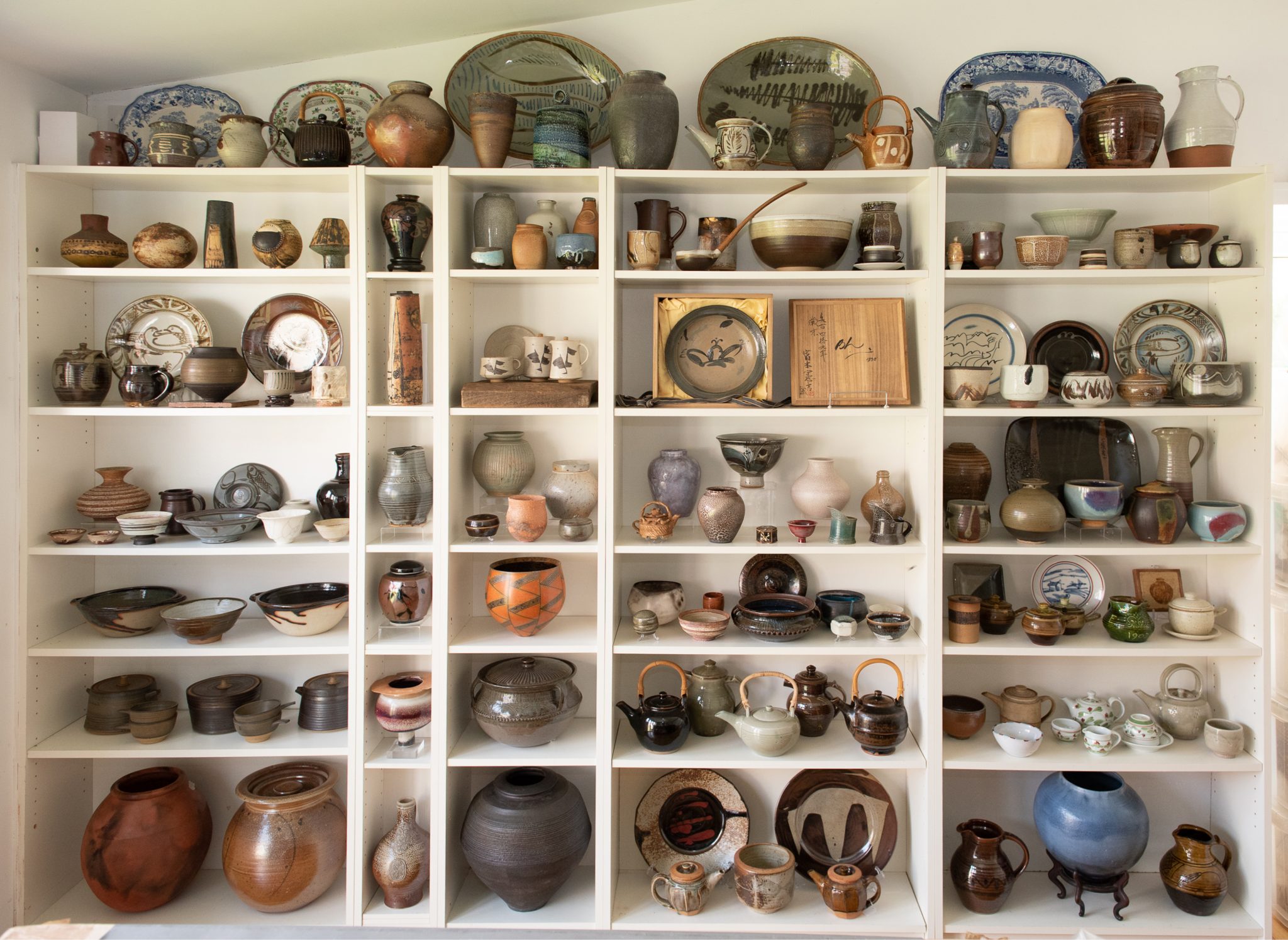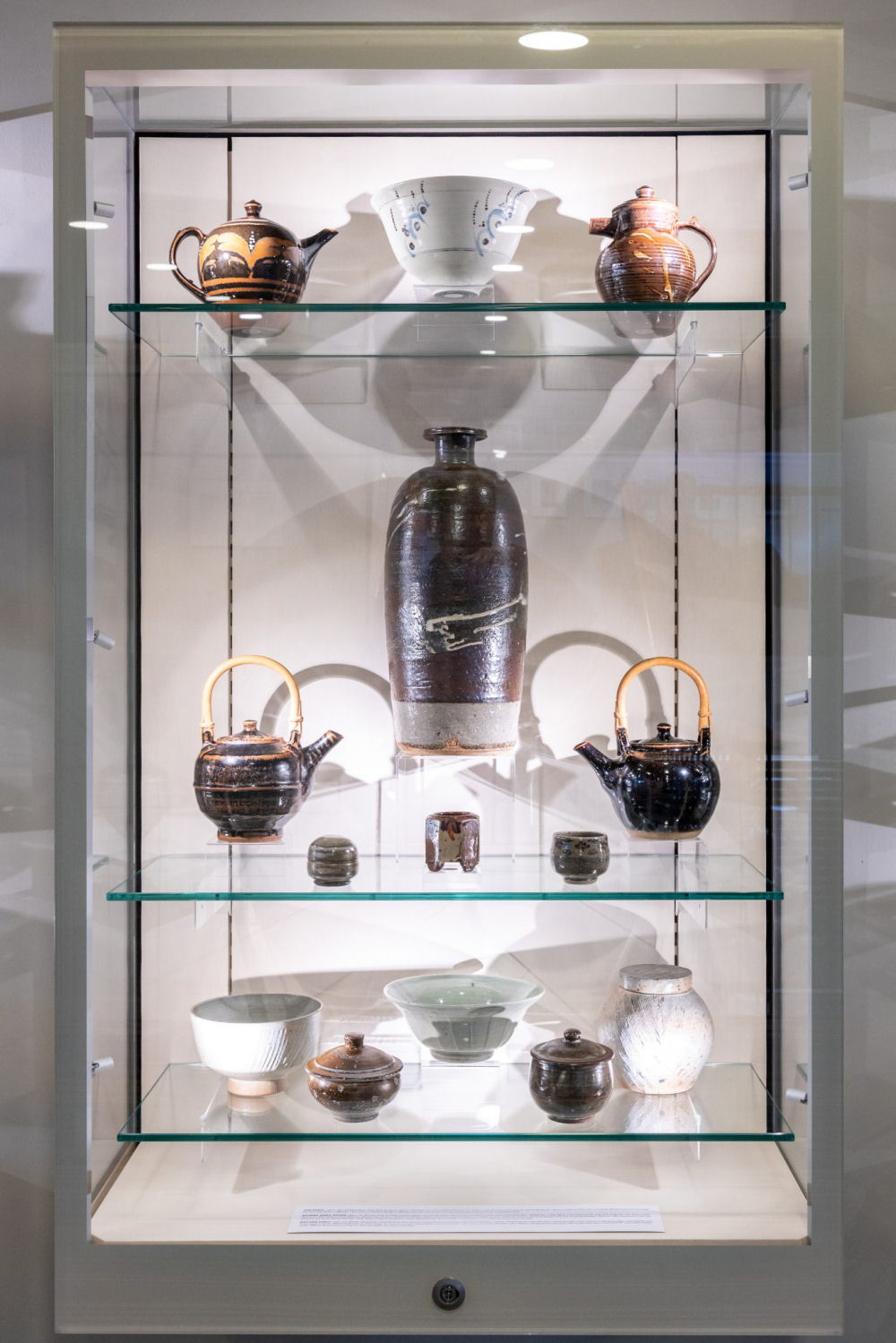When I spoke to Professor Gordon Bell in 2022, he told me that he and his wife were in negotiations to leave their studio pottery collection to Clare Hall,
a college for advanced study at Cambridge University. The bequest has been made and since March 2023 the pots have been on public display at Clare Hall.
The collection comprises 320 pots which are to be exhibited on a rotating basis in a set of display cases at the Porter's Lodge.
Admission to the gallery is free and it is open daily from 10am to 5pm.
The Bells journey into studio pottery began in 1963 and their collection includes pieces by leading potters such as Bernard Leach, Shoji Hamada, Michael Cardew, Richard Batterham,
Bill Marshall, Janet Leach and Alan Wallwork.
With Kettle's Yard, the Fitzwilliam and Cambridge Ceramics, Cambridge already had much to attact pottery lovers, there are now more delights to see at Clare Hall. I for one will be visiting soon.

A Part of the Bell Collection prior to its move to Clare Hall. Photo: G.H. Bell

I asked Professor Bell a few questions about
his collection and the decision to bequest, here are his answers:
What first kindled your interest in studio pottery?
My wife and I met in 1958 during our initial teacher training. Her main
subject was craft, mine was art. We both taught in London in the 1960s.
I became Head of an Art Department and introduced clay into the school after
attending a Summer School in 1962 at Loughborough College of Art.
What were your first purchases?
My wife attended classes with Robert Fournier. We purchased several of
his functional pots and commissioned him to make us a coffee set for our wedding
in 1963. We became aware through him of Alan Wallwork (and Bernard Rooke and
Ian Auld) and bought several pieces by Wallwork at the time.
Our 'mini moon' [honeymoon] was a three-day dash to St
Ives where we bought pieces by David Leach and had correspondence with Bernard
Leach on our return (now in the Leach Archive at the Crafts Study Centre,
University of the Creative Arts, Farnham). We also discovered David Hilton's
Ham Lane Pottery en route and returned there in the following summer to spend
a week working with him and purchasing some of his pots.
Which potters do you admire the most?
Oh dear - that's a hard choice - mostly wood fired, and raku potters
committed to a Leachian lifestyle ethic. Also, Japanese potters associated
with Leach as represented in the Bell Collection (1920-1980). Outside that
period in a personal collection, I enjoy the work of several continental potters
e.g., Christine Fabre, Vincent Potier, and Eric Astoul.
And not forgetting the Sung Dynasty and early Korean ceramics!
What are your favourite pots?
It depends on the day! My responses to pots are a complicated amalgam
of sentiment, associations, historic context, and aesthetics blending and
flowing over time.
Of the exhibitions you visited, which were the most memorable?
London in the Sixties made it possible to make frequent visits to the
Design Centre (cf. Marianne de Trey), to Liberty's, Heal's Mansard Gallery,
and the Craftsman Potters Association. I strongly remember an early visit
to The Percival David Collection in Gordon Square at that time.
Much later, I much enjoyed the David Leach Retrospective on tour at the Cartwright in
Bradford, visiting COCA, York, and most recently their temporary show of African
Potters including Ladi Kwali, Cardew and Odundo and not least the superb Bill
Ismay Collection.
Why did you decide to bequeath your collection to Clare Hall?
To make it possible for others to experience whatever the Bell Collection
represents.
The critical issue was where? We did not want a museum as there would be no guarantee that the Collection would get displayed and would likely end up in storage. Moreover, there appears to be a somewhat antiseptic ambience in even the very best of museums. We lived in North Essex for 12 years whilst commuting to London and often visited Cambridge including the Fitzwilliam. I was seconded to the Cambridge Institute for a year and later taught in the university.
We became aware of the Cambridge workshop of Lida Cardozo Kindersley and the work of David Kindersley in the 1960s. We then commissioned Lida to letter-cut several works on glass and slate including the design of the Bell Collection seals. This led us to Clare Hall where the signage is all by her. We then became aware of the significance of the design-era of the original buildings (Ralph Erskine, 1914-2005, Grade2*listed) and the potential of superb spaces for studio pottery. As it is a residential graduate College, there is an ever-changing audience of young people from all the world and a lively programme of Visiting Fellows, Seminars, Music, and Art Exhibitions. Over several months, we negotiated an agreement that ensures a rotating display, a Board of Management that includes the Fitzwilliam, and a constitutional presence for the Collection as a University asset.

Further information: